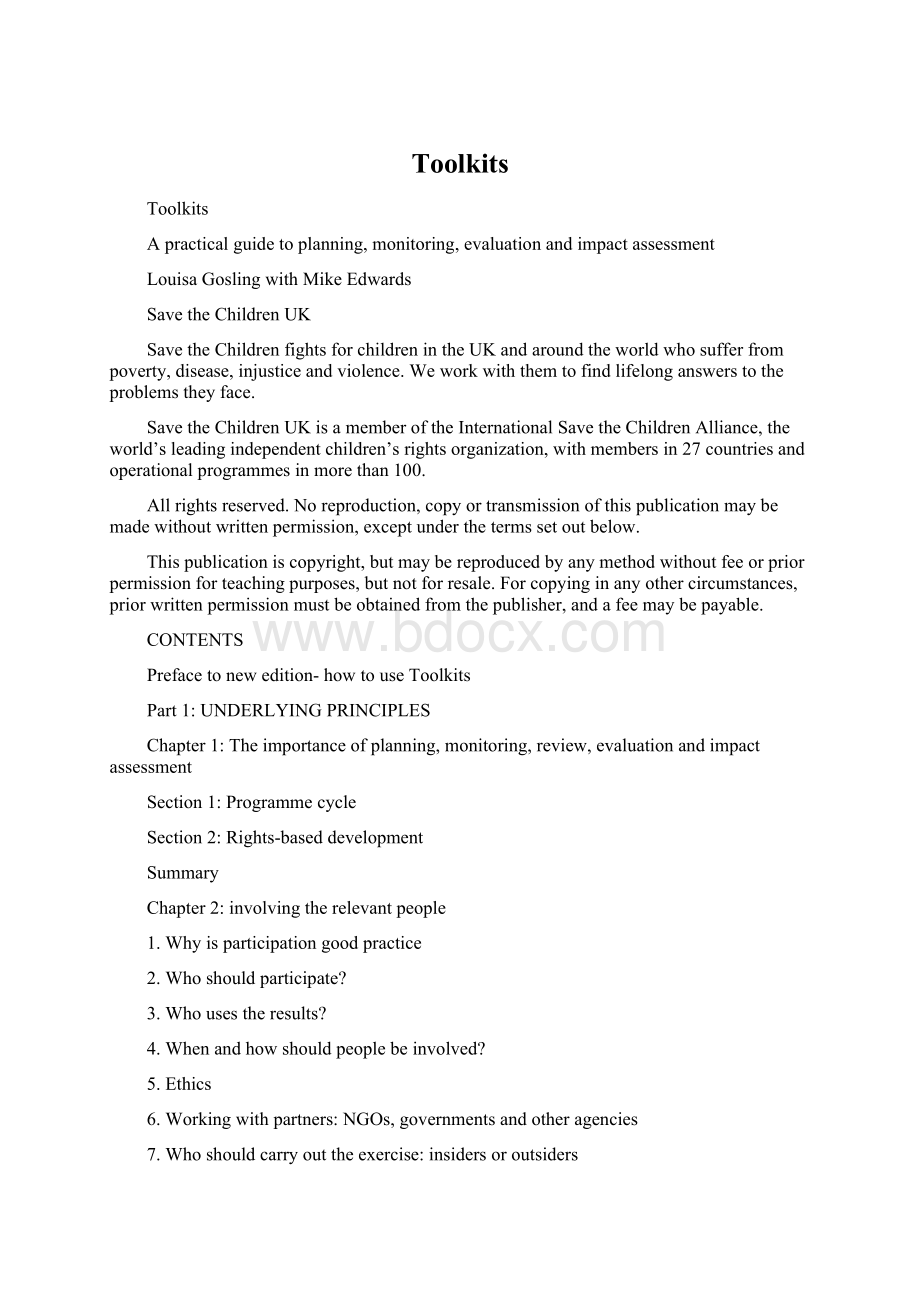 Toolkits.docx
Toolkits.docx
- 文档编号:3336683
- 上传时间:2022-11-21
- 格式:DOCX
- 页数:14
- 大小:39.26KB
Toolkits.docx
《Toolkits.docx》由会员分享,可在线阅读,更多相关《Toolkits.docx(14页珍藏版)》请在冰豆网上搜索。

Toolkits
Toolkits
Apracticalguidetoplanning,monitoring,evaluationandimpactassessment
LouisaGoslingwithMikeEdwards
SavetheChildrenUK
SavetheChildrenfightsforchildrenintheUKandaroundtheworldwhosufferfrompoverty,disease,injusticeandviolence.Weworkwiththemtofindlifelonganswerstotheproblemstheyface.
SavetheChildrenUKisamemberoftheInternationalSavetheChildrenAlliance,theworld’sleadingindependentchildren’srightsorganization,withmembersin27countriesandoperationalprogrammesinmorethan100.
Allrightsreserved.Noreproduction,copyortransmissionofthispublicationmaybemadewithoutwrittenpermission,exceptunderthetermssetoutbelow.
Thispublicationiscopyright,butmaybereproducedbyanymethodwithoutfeeorpriorpermissionforteachingpurposes,butnotforresale.Forcopyinginanyothercircumstances,priorwrittenpermissionmustbeobtainedfromthepublisher,andafeemaybepayable.
CONTENTS
Prefacetonewedition-howtouseToolkits
Part1:
UNDERLYINGPRINCIPLES
Chapter1:
Theimportanceofplanning,monitoring,review,evaluationandimpactassessment
Section1:
Programmecycle
Section2:
Rights-baseddevelopment
Summary
Chapter2:
involvingtherelevantpeople
1.Whyisparticipationgoodpractice
2.Whoshouldparticipate?
3.Whousestheresults?
4.Whenandhowshouldpeoplebeinvolved?
5.Ethics
6.Workingwithpartners:
NGOs,governmentsandotheragencies
7.Whoshouldcarryouttheexercise:
insidersoroutsiders
Summary
Chapter3:
Recognizinganddealingwithdifferencesanddiscrimination
Recognizingdifferences,avoidingdiscrimination
Avoidingdiscrimination
Summary
Chapter4:
thesystematiccollectionandanalysisofinformation
Theprinciplesofbeingsystematic
Quantitativeandqualitativemethods
Whentousedifferentmethods
Summary
Part2:
PRACTICALQUESTIONS
Chapter5:
questionstoconsiderwhenundertakingplanning,monitoring,review,evaluationorimpactassessment
Termsofreference
1.Aimoftheexercise
2.Whoisitforandhowwilltheyusetheresults?
3.Objectivesandkeyquestionsoftheexercise
4.Informationcollectionanalysis
5.Presentingtheresultsandusingthefindings
6.Organisation
Summary
Chapter6:
Assessmentandprogrammeplanning
Designinganassessmentandplanningexercise
Thestageofassessmentandprogrammeplanning
Stage1:
problemidentification
Stage2:
carryingoutasituationanalysis
Stage3:
programmedesign:
howtoaddresstheproblemidentified
Stage4:
programmeappraisal
Stage5:
approvalandbaselinestudies
Summary
Chapter7:
monitoring
Typesofmonitoring
Designingamonitoringsystem
1.Definingtheaimofthemonitoringsystem
2.Theselectionofrelevantinformation
3.Thecollectionandanalysisofdata
4.Presentingandusingtheresults
5.Organisation
Summary
Chapter8:
Reviewandevaluation
Theroleofreviewandevaluation,andthedifferencesbetweenthem
Importantquestionstoconsiderwhencarryingoutareviewofevaluation
1.Thepurposeandaim
2.Whoisitforandhowwilltheyusetheresults
3.Objectivesandkeyquestions
4.Informationcollectionandanalysis
5.Presentingtheresults
6.Organisation
Summary
Chapter9:
impactassessment
1.Whatisimpactassessmentandhowdoesitrelatetoplanning,monitoring,reviewandevaluation
2.Carryingoutastudythatfocusesonimpact
3.Clarifyingtheobjectivesandkeyquestionsoftheexercise
4.Informationcollectionandanalysis
5.Carryingoutarevieworevaluationthatfocusesonimpact:
methodsandorganisation
Summary
Chapter10:
planning,monitoring,reviewandevaluationinemergencysituations
Introduction
1.Constraintsandcompromises
2.Specificaimandobjectives
3.Keyquestionsandindicatorsrelevantinemergencies
4.Methodsforcollectingandanalysinginformation
5.Presentingfindings
Summary
Chapter11:
Planning,monitoringandevaluatingadvocacy
1.Whatisadvocacy?
2.Settingadvocacyaimsandobjectives
3.Decidingwhattomonitorandevaluate
4.Howcanadvocacybemonitoredandevaluated?
Summary
Part3:
TOOLS
Tool1:
participatorylearningandaction(PLA)
Tool2:
Surveys
Tool3:
Logicalframeworkanalysis(LFA)
Tool4:
Cost-effectivenessanalysis
Tool5:
Strengths,weaknesses,opportunitiesandconstraints(SWOC)analysis
Tool6:
Settingobjectives
Tool7:
Exampleofevaluatingparticipation
Tool8:
usingconsultants
Tool9:
programmeorprojectvisit
Tool10:
presentingandsharinginformation:
meetings,diagrams,videoandtheatre
Tool11:
traininganddevelopmentinplanning,monitoring,review,evaluationandimpactassessment
Tool12:
stakeholderanalysis
Tool13:
frameworkstohelpanalysetheadvocacyprocess
Tool14:
frameworksfordevelopingmonitoringandevaluationquestionsinemergency
Referencesandfurtherreading
Evaluationandimpactassessment:
corereading
Methodsofinformationcollectionandanalysis
Advocacy
Emergencies
Evaluation
Disabilityandevaluation
Monitoringandevaluationontheinternet
Glossary
Acknowledgements
ThiseditionofToolkitshasbeenbasedoncontributions,commentsandadvicefromalargenumberofpeoplefromSavethechildrenUKprogrammesthroughouttheworld,andfromoutsidetheorganisation.Allofthesecontributionshavebeeninvaluableinguidingboththecontentandstyleofthebook.MembersoftheLearningandImpactAssessmentNetworkofSavetheChildrenUKhaveplayedacrucialroleinidentifyingnewissuestobeincorporated,contributingtothecontentandcommentingonthenewchapters.Individualsthroughouttheorganisation–toonumeroustoname–havecontributedideas,experienceandindividualcasestudies.ManypeoplefromdifferentsectionsoftheLondonofficehavealsoputagreatdealoftimeandeffortintoreadingandcommentingonvariousdraftsofthedifferenttoolsandchaptersofthebook.ThewholeprocesshasbeendiligentlyguidedandmanagedbyMartaForestiwithsupportfromSimonStarling,CarrieStebbings,andjohnWilkinsonfromtheLearningandImpactAssessmentteaminLondon.Anymistakes,inaccuraciesortractsofpoorwritingareentirelytheresponsibilityoftheauthor.
Prefacetothenewedition
AfterconsultationwithpeoplewhouseToolkits,itwaddecidedthataneweditionshouldincorporatethefollowingchanges:
∙Greaterrecognitionoftheroleofplanning,monitoring,reviewandevaluationforlearning,bothintheshortandlongterm,andforensuringgoodpractice,andimprovingbothpolicyandpractice.
∙Moreemphasisonassessingthewiderimpactofworkandconsideringtheshort-termandlong-termimplicationsofinterventions;alsomoreemphasisonattribution(iftherehasbeenachange,howdoyouknowwhatcausesit?
)(SeethenewChapter9onimpactassessment.)
∙Moreemphasisonadvocacyandonhowitcanbemonitoredandevaluated(SeeChapter11andTool13.)
∙Ashiftfrom“needs-based”towards“rights-based”approachestodevelopment.SavetheChildrenisachildren’srightsorganisation,andthereforeadoptsarights-basedapproachtoprogramming.Thisneweditionaimstoshowhowthekeyprinciplesofchildren’srightscanbeappliedtoexistingapproachestoplanning,monitoring,reviewandevaluation.(SeeChapter1forfurtherdiscussionofrights-basedprogramming.)
∙Moreexperienceofusingparticipatoryapproaches,andinparticularpromotingtheparticipationofchildren.
Experienceshowsthatchildren’sview,notonlyforchild-focusedagencies.Therearenewcasestudiesthroughoutthebooktoillustratehowchildrencanparticipate.(Seealsochapters2and3andTool1.)
∙Moreemphasisonworkwithpartners.Thismeansadoptingamoreinclusiveapproachtoplanning,monitoring,reviewandevaluation.Newcasestudieshavebeenincludedtoillustratethis.
∙ThedevelopmentofSPHEREminimumstandardsforhumanitarianemergencyprogrammes.
HowtousToolkits
Toolkitsshouldbeusedasyouwouldareal“toolkit”,byselectingtheparticulartools(inthiscase,approachesortechniques)thatyouneedtodealwithaspecificproblem.
Developmentworkrarelyconformsinpracticetotheidealmodelsfoundinthetextbooks.Thesameistrueforthetechniquesandapproachesdescribedhere.Whenappliedinpractice,theyalwayshavetobeadaptedtolocalcircumstances.Thecasestudiesillustratesomewaysinwhichthishasbeendone.
Monitoringandevaluationtoolsarenotnewandmanyofthemaresimplywaysofusingcommonsensesystematically.Theyaredesignedtoassistinthewholestrategicplanningprocessbyprovidingsomeofthemeanstomakedecisionsinchangingcircumstancesinasystematicway.
StructureofToolkits
ThisbookhasthreeParts:
Part1shouldbereadfirstwhenundertakinganyplanning,monitoring,review,evaluationorimpactassessment.Itlooksatgeneralissuesthatarerelevanttoalltheseexercises.
∙Whyplanning,monitoring,review,evaluationandimpactassessmentareessentialtodevelopmentworkandhowtheylinktoplanninganddecision-making(Chapter1)
TheremainingchaptersinthisPartexaminethebasicconsiderationsthatneedtobeappliedthroughoutassessment,monitoring,reviewandevaluationifthefindingsaretobeusefulandrelevant.Theseunderlyingprinciplesare:
∙Involvetherelevantpeople(Chapter2).
▪Whoshouldparticipateinplanning,monitoring,review,evaluationandimpactassessment?
Whousestheresults?
▪Feedbackofthefindingstothoseinvolvedinthework.
▪Confidentiality
▪Workingwithpartners:
NGOs,governmentsandotheragencies.
▪Whoshouldcarryouttheexercise:
programmestafforoutsiders?
▪Differentapproaches:
participatory,non-participatoryandjoint.
∙Recogniseanddealwithdiff
- 配套讲稿:
如PPT文件的首页显示word图标,表示该PPT已包含配套word讲稿。双击word图标可打开word文档。
- 特殊限制:
部分文档作品中含有的国旗、国徽等图片,仅作为作品整体效果示例展示,禁止商用。设计者仅对作品中独创性部分享有著作权。
- 关 键 词:
- Toolkits
 冰豆网所有资源均是用户自行上传分享,仅供网友学习交流,未经上传用户书面授权,请勿作他用。
冰豆网所有资源均是用户自行上传分享,仅供网友学习交流,未经上传用户书面授权,请勿作他用。


 如何打造酒店企业文化2刘田江doc.docx
如何打造酒店企业文化2刘田江doc.docx
